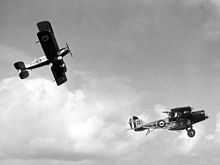Pink's War
| Pink's War | |
|---|---|
| Part of the South Waziristan | |
| Result |
British victory (see Operations section) |
One aircraft lost
Pink's War was an air-to-ground bombardment and strafing campaign carried out by the
South Waziristan in March and April 1925. It was the first independent action by the RAF, and remains the only campaign named after an RAF officer.[1][2]
Background
The defence of the
British India. In the 1920s, the British were engaged in a continuing effort to defend British Indian Army bases against raids from Native Pashtun tribesmen in the province. In July 1924, the British mounted operations against several of the Mahsud tribes in southern Waziristan and by October most tribes had ceased their activities. Only the Abdur Rahman Khel tribe and three other supporting tribes continued to attack army posts.[3]
Operations

After the successful use of aerial bombardment in the
de Havilland DH.9As from 27 and 60 squadrons deployed to a forward operating base at Miranshah.[3] Operations commenced on 9 March 1925,[4] and following an initial sortie to drop warning leaflets on the targeted areas, the RAF squadrons strafed tribal mountain strongholds in a successful attempt to crush the rebellion.[3][2] Operations focused on causing disruption to day-to-day activities for the militant tribes, as well as preventing access to safe havens; sorties were flown at night as well as during the day, in order to cause further disruption.[3]
On 1 May 1925, after just over 50 days of bombing, the tribal leaders sought peace to end the bombing, bringing the short campaign to a close.[2] Only two British lives and one aircraft were lost during the campaign; Mahsud casualties are not known.[2][3] Pink's War was the first air action of the RAF carried out independently of the British Army or Royal Navy.[2]
Honours
After the campaign was over, the
Leading Aircraftman William Alfred Walmsley.[8] A further 14 men were mentioned in dispatches, including flying officers Edward Dashwood and Noel Hayter-Hames, who both died in the campaign.[8]
See also
- Bacha Khan
- Mirzali Khan
- Mullah Powindah
References
- ^ a b c d e "Royal Air Force History – RAF History Timeline 1918 to 1929". Royal Air Force. 2003. Archived from the original on 2 January 2010. Retrieved 8 September 2007.
- ^ a b c d e f g Smith, Richard. "Pink, Richard Charles Montagu (1888–1932)". Oxford Dictionary of National Biography. Archived from the original on 9 November 2013. Retrieved 15 May 2013.
- ISBN 1-85310-451-5.
- ^ Laffin, John (1964). Swifter than Eagles. A biography of Marshal of the RAF Sir John Salmond. William Blackwood & Sons Ltd. pp. 207–208.
- ^ "New Year Honours, Royal Air Force". The London Gazette. Retrieved 8 May 2013.
- ^ "No. 33119". The London Gazette (Supplement). 29 December 1925. p. 10.
- ^ a b "No. 33104". The London Gazette (Supplement). 20 November 1925. pp. 7595–7601.
Further reading
- Bowyer, Chaz (1988). "Chapter Eight: Pink's War". RAF Operations 1918–1938. London: William Kimber. ISBN 0-7183-0671-6.
- Air Power Review – Volume 13 Number 3 Autumn/Winter 2010 – Pink’s War – Applying the Principles of Air Control to Waziristan – Lieutenant Colonel Andrew Roe
External links
- The Small Wars at the Royal Air Force official website
